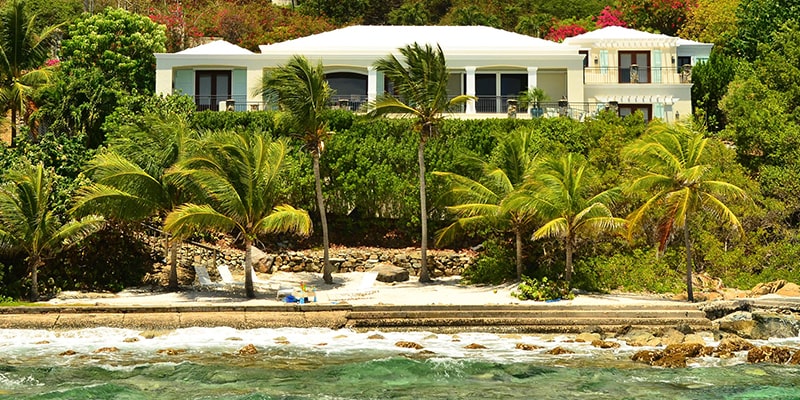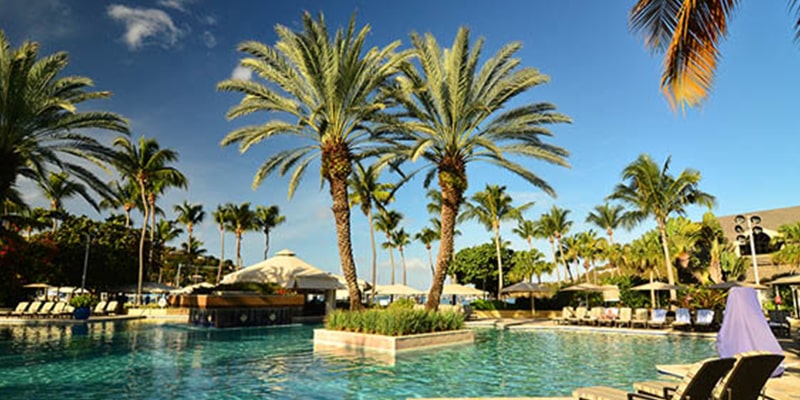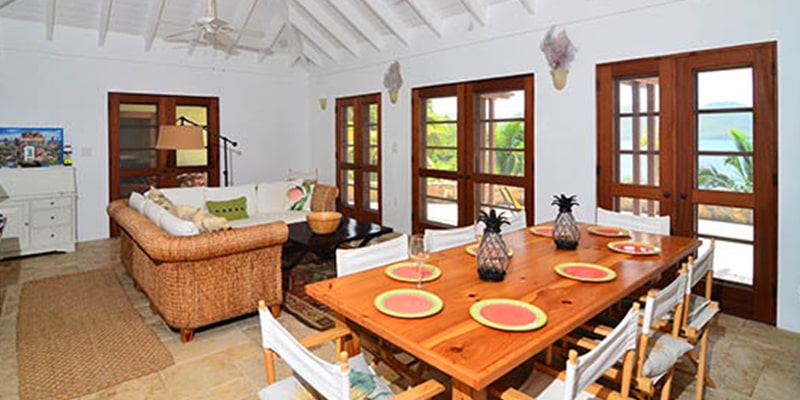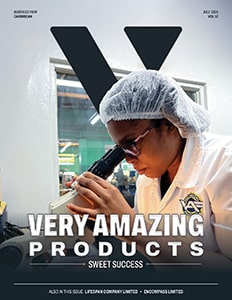Building Paradise, One Permit at a Time
Expertly navigating two-year permit delays and earthquake zones to fill the Virgin Islands’ luxury housing gap
In the U.S. Virgin Islands, where turquoise waters meet some of the Caribbean’s most coveted real estate, a critical shortage grips the luxury housing market. For buyers seeking homes above $2.5 million, options remain frustratingly scarce, with existing properties often requiring extensive renovation due to decades of salt erosion and outdated construction standards.
Jeff Fetterhoff, Chief Operating Officer of JPK Developments, identifies a market reality that drives his company’s business model. “If someone wants to spend $5 million on a home, there might only be two or three options, and that home probably needs a million to $2 million worth of work,” he explains. The problem runs deeper than simple inventory shortage. Many homes built in previous decades used beach sand containing high salt content, which now corrodes steel foundations beyond repair.
JPK Developments, established in 2002, has positioned itself to fill this gap by acquiring desirable land and developing hurricane-proof spec homes. The company’s approach targets international buyers who come from around the world to own Caribbean property. The firm has built over 100 residential homes, villas, and commercial properties across two decades, including substantial hurricane reconstruction work. Unlike many competitors, JPK maintains 38 full-time employees, including 28 skilled masons specializing in the concrete construction essential for surviving the territory’s extreme weather conditions and seismic activity from the nearby Puerto Rican trench.
Island Bureaucracy
The path from land acquisition to completed home in the Virgin Islands tests even seasoned developers’ patience. “The average time to design a home with an architect could take anywhere between four to eight months,” Fetterhoff explains. But that marks just the beginning. The coastal zone management process, which protects the islands’ fragile coastlines from erosion and environmental damage, adds another significant delay. “That process in and of itself takes around 12 to 15 months, and then you’ve got to go through the Department of Planning and Natural Resources for a building permit, which could take four to six months.”
Property closings themselves move at island pace, typically requiring 120 days. By the time a buyer closes on land and goes through the full permitting process, they face a sobering timeline. “You don’t even break ground for the first two years,” Fetterhoff states. “That is really a hard selling point for people in my industry to say, ‘Hey, yeah, we want to build your house, but it’s going to take two years to even break ground.'”
The territory’s Building Codes, which include the 2018 International Building Code and multiple specialized codes for everything from energy conservation to fire safety, add complexity. A government audit revealed additional challenges, with some developers proceeding without proper permits and the Division of Permits struggling to track compliance effectively. JPK’s solution involves acquiring land years in advance, completing the permitting process, and then marketing properties as construction begins. The company finds buyers who can customize their homes during the build process, turning regulatory delays into opportunities for personalization.

Building for Nature’s Extremes
The Virgin Islands’ stunning geography conceals formidable construction challenges. Positioned near the Puerto Rican trench, the second-largest fault line globally after San Andreas, the territory experiences over a thousand earthquakes annually, with magnitudes reaching 5.2. Combined with hurricane threats and corrosive salt air, these conditions demand exceptional building standards.
“We’re building for seismic activity as well as wind and water activity,” Fetterhoff emphasizes. “We get anywhere between two to three earthquakes a day.” JPK’s response involves full concrete construction from floor to ceiling, a departure from typical mainland building methods. The company’s expertise in masonry proves essential for structures that must withstand both Category 5 hurricanes and constant seismic stress.
Terrain presents additional obstacles. “A lot of times we have to hand dig for certain things because we can’t get the trucks and the machinery into a certain location,” Fetterhoff explains. “They’ll have to carry every board in and every board out at the end of the day.” When JPK built a solar farm installing 40,000 panels on cliff faces, they hired 60 additional laborers to hand-carry materials across steep, inaccessible terrain.
The company’s architect partner designs specifically for these constraints, understanding that plans may require sudden adjustments. “We could break ground and have to move the house 20 feet to the left or 20 feet to the right because of a rock that can’t be moved,” Fetterhoff notes. Many architects overdesign structures, inflating costs unnecessarily. JPK’s integrated approach, with Jay Knoepfel bringing three decades of local construction experience, allows them to balance structural integrity with practical island engineering.
The Power of Local Partnerships and Loyal Crews
JPK’s success hinges on relationships cultivated over decades, both with suppliers and employees who understand island construction’s unique demands. “Getting anything from concrete to steel to plumbing fixtures and finishes, we rely on all of our vendors for those things,” Fetterhoff explains. Material acquisition resembles grocery shopping on the island, where completing a list requires visiting multiple specialized stores.
JPK maintains relationships with Heavy Materials for concrete supply, Unimix for additional materials, MSI and Interiors for building supplies, and East End Lumber for specialty items. Speed often trumps price in their calculations. “If it costs an extra hundred dollars for one person, but it’ll get here three days later, that hundred dollars is a drop in the bucket compared to 25 guys standing around waiting,” Fetterhoff notes.
The company’s 38 full-time employees, particularly its 28 masons, form the backbone of operations. Several have worked with Jay Knoepfel for three decades, bringing irreplaceable institutional knowledge. “They care as much as we do about how we’re building and what we’re building,” Fetterhoff says. “We always say if you see something, say something.” Unlike many island contractors operating on relaxed schedules, JPK maintains mainland efficiency. “Our guys are never on island time because there’s always more work for them.”
From Commercial Spaces to Keeping Talent Home
Beyond luxury residences, JPK tackles the territory’s broader development challenges, including the exodus of educated locals who find limited career opportunities after college. “People are born here, they’re educated here, then they go to college in the States, and then there’s no jobs for them to return home to,” Fetterhoff observes.
JPK’s commercial projects aim to reverse this brain drain. The company recently secured contracts for two three-story medical office buildings near the hospital, addressing the territory’s acute shortage of modern professional space. “We don’t have a lot of office space. We do not have a lot of retail space that is new and has all of the nuances of some of the new construction in the states.”
Past projects demonstrate JPK’s range, from building the ICMC headquarters—the territory’s largest employer—to constructing Lovango Resort and contributing to Westin St. John renovations. The company also completed reconstruction of a 6.4-megawatt solar farm following hurricane damage, installing 40,000 panels and 2,000 solar tables across challenging terrain.

Currently, JPK is developing a 40,000-square-foot sports complex featuring indoor rock climbing, pickleball, basketball courts, and event space. “A lot of these schools don’t have indoor gyms to practice volleyball or basketball,” Fetterhoff explains. “They don’t have basketball teams because they don’t have space to practice.” The facility will serve both tourists and locals, providing schools with desperately needed athletic facilities.
Custom Homes, Off-Grid Living
JPK’s residential projects embrace customization and self-sufficiency, reflecting the islands’ infrastructure realities and buyers’ desires for personalized luxury. “Our goal is to hopefully find a buyer that can enter into a construction contract that would allow them to make certain changes,” Fetterhoff explains. “How large they want their closets, what their bathrooms look like, what colors, what tile, what fixtures, whether they want to add a garage or a gym or an apartment.” Currently, JPK has a $4.5 million home 75% complete. “We’re right at that point where we want to find a buyer, otherwise we’re going to start painting it the colors we want and putting the tile that we want.”
Self-sustainability defines every JPK home, driven by necessity rather than environmental idealism alone. “All of our water is collected in giant eight- to 10-foot-tall concrete rooms underneath our homes that collect water from our roof,” Fetterhoff details. “That’s the only way that we get water here. We don’t hook up to water lines or sewer lines.” Solar panels with battery backup and generators provide power independence, while septic systems handle waste management.
Recent visits to the International Builders Show in Las Vegas introduced new technologies that could enhance these off-grid capabilities. “There’s so much unique technology and there were so many different products that we have never seen, heard of, or even thought existed,” Fetterhoff says. The company explores innovations in composites, stronger steels, and sustainable materials, even considering 3D-printed homes already tested in Trinidad and Tobago for hurricane and seismic resistance.
A Partnership Built on Complementary Skills
Hurricane Irma’s devastation in 2017 catalyzed an unlikely partnership that would reshape JPK’s trajectory. As the storm’s aftermath revealed both the fragility of older construction and the resilience of quality building, Fetterhoff witnessed something remarkable in Jay Knoepfel’s response to the crisis.
“After the storm, he was the first person I saw out the door and he was checking on clients for homes that he had built, and it was like the day after,” Fetterhoff recalls. “He had 142 jobs going on simultaneously. He didn’t know if he was making money, losing money.” This dedication, combined with the fact that both of Fetterhoff’s JPK-built homes survived the hurricane intact, convinced him to join forces with Knoepfel.
Fetterhoff brought financial expertise crucial to the post-hurricane landscape. “My background is finance, and I was doing a lot of distressed mortgage purchasing at the time,” he explains. The partnership expanded to include architect Scott Burnley, creating what Fetterhoff calls “the perfect storm of partnership.” They began acquiring distressed properties from owners overwhelmed by tax debt or properties stuck in probate for years. “We pay full price for the land. We know its value. We don’t try to negotiate whatever the offering is.”

The trio’s complementary skills streamline development from conception to sale. “Jay will quickly understand what type of house needs to be built there, then he’ll relay that information to Scott. Scott will design and draw that house, and Jay will start building it and I’ll start selling it immediately,” Fetterhoff says.
Their approach transforms regulatory obstacles and natural disasters into competitive advantages, creating inventory where others see only barriers. In a territory where building takes patience, persistence, and deep local knowledge, JPK Developments has mastered the art of island construction.
At a Glance
Who: JPK Developments
What: Full-service construction company specializing in high-end residential spec homes and commercial projects
Where: St. Thomas, U.S. Virgin Islands
Website: www.jpkvi.com
PREFERRED VENDORS/PARTNERS

WestHem Supply: www.westhemsupply.com
WestHem Supply is a family-owned exporter of building materials located in Florida. Our founders have decades of experience supplying the construction industry and exporting to five continents. Contact us today to see how we can help on your next construction project.

Heavy Materials LLC: www.heavymaterialsvi.com
Heavy Materials is a leading producer and supplier of high quality ready-mixed concrete, construction aggregates and sand in the U.S. Virgin Islands. Our material quality and prompt barge delivery service are second to none and our goal is to provide you with courteous, expedient, professional service of the highest caliber.

Berry’s Screens: 340-998-0327
Established in 1939, the Shipping Association of Jamaica (SAJ) is a member-based organisation representing terminal operators, stevedoring contractors, and shipping agents – key players in the movement and logistics of cargo through Jamaica’s ports. With over 80 member companies, the SAJ partners with government and industry stakeholders to strengthen the shipping sector.




 This information will never be shared to third parties
This information will never be shared to third parties